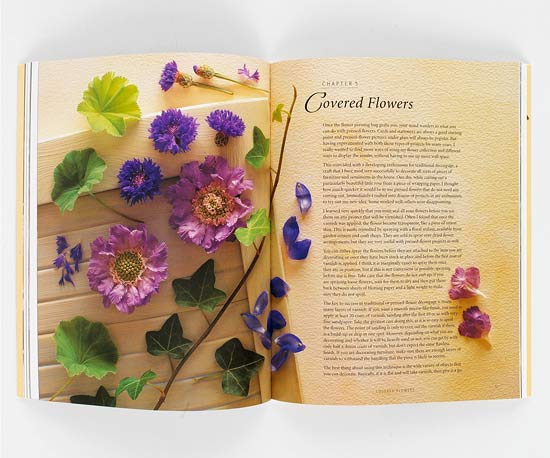






Pressed flowers preserve a moment in time. They evoke a remembrance of a special bouquet from a loved one or a stunning pansy bloom that caught your eye in spring. They seem to keep summer alive almost forever.
Unlike a bouquet of dried flowers, pressed flowers are perfect for framing, placing inside a locket, or using as adornments for note cards. Here's how to make your own pressed flowers.
Selecting Flowers for Pressing
Pick flowers in the morning after dew has evaporated. Harvest them when they are ready to open their buds or just before their peak. If you plan to create framed pressed-flower art, collect blooms and foliage at various stages of development to give your design a natural look. The better the quality of the blooms at picking time, the better they will look when dried and pressed.
For best results and the most vibrant colors, condition your blooms first. Plunge the stems into water immediately after cutting, then hold the stems underwater in a sink and recut the stems at an angle to allow the greatest water absorption. Place them in a clean vase filled with water and floral food.
The easiest flowers to press are those with naturally flat blooms such as violets, daisies, and single-petal roses (many types of shrub roses are good choices). If you are pressing flowers with obvious stamens, such as alstroemerias and lilies, remove the stamens so the pollen won't stain. Ferns and various types of leaves also flatten nicely.
You can dry chunky flowers such as multipetal roses or carnations (or even fruits and vegetables), but they will take longer and require a bit more attention.
Get more tips for drying flowers.
You need newspaper; blotting paper; printer paper; flat, noncorrugated coffee filters; flat cardboard; or plain, untreated facial tissues to absorb moisture and aid drying. Your goal is to dry flowers as quickly as possible to prevent browning.
Avoid paper towels because their textures may be imprinted on the petals. Also avoid waxed paper because it retains moisture.
Experiment with pressing techniques to discover which one works best for you and the flowers you choose. Trial and error will also show you how to place the blooms on the paper so they look their best when pressed.
You can buy or make a wooden flower press, but the following techniques operate on the same principle.
The easiest method of flower pressing requires no special equipment other than absorbent paper and a heavy book or phone book. Pigments in the petals, stems, and leaves may stain the paper, so if the book is valuable, protect the pages with a layer of paper on each side of the plants being pressed.
There are two ways to press using this technique. Start by placing the flowers between two layers of absorbent paper, then placing heavy books on top. Or place the flowers between the pages of the book itself, leaving at least 1/8 inch between multiple pressings. Weigh down the top of the book with a brick or other heavy item.
Let the flowers dry for a week before checking on them. At that point you may want to replace the absorbent material. Allow two to three weeks for complete drying.
Like the other methods, this one begins with pressing the flowers between two pieces of absorbent paper.
Heat an iron to a low setting. Empty any water from the iron and do not add water. You do not want to add moisture with steam.
Prepare the flower for pressing by placing it between two sheets of absorbent paper. Flatten the flower with a heavy book first, then press the warm iron on top of the upper sheet of paper for 10 to 15 seconds. You don't need to make a gliding motion as if ironing. Wait for the paper to cool for another 10 to 15 seconds, then repeat. Check occasionally by very carefully lifting the paper to see if the flower is stiff and dry.
Using high heat on flowers might cause them to turn brown, but if you are in a hurry, you can use a microwave to speed the drying process.
For best results pressing flowers with a microwave, use a professional microwave flower press designed for this purpose. Follow directions, placing the flower between two pieces of absorbent paper and using 30- to 60-second zaps, allowing the plant material to cool between microwave uses. If you are drying more than one set of blooms, alternate cooling and heating with two microwave presses.
In a pinch, you can create your own microwave flower press using two ceramic tiles and rubber bands to hold the tiles tightly together. Place the flowers between two sheets of absorbent paper, then press between the ceramic tiles. Heat for 30 to 60 seconds at a time, allowing the materials to cool before repeating.
Or place the flowers inside a book (be sure there is no metal in the binding). Heat the book for 30 to 60 seconds at a time, checking to see when the flowers are dry. Allow the book to cool for a minute or two between zaps. Do not microwave the book for longer than a minute at a time.
When the flowers are dry, finish the process with the traditional air-drying press with a book or heavy object. The flowers should be finished in a day or two.
Copyright © www.100flowers.win Botanic Garden All Rights Reserved